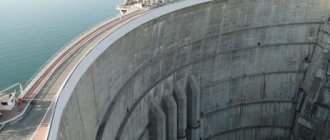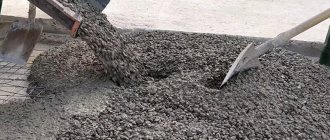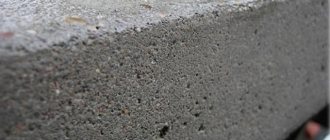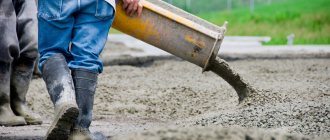Industrial construction does not stop during the cold season, but concrete hardening at subzero temperatures is problematic. Crystallization of water leads to a decrease in strength, which negatively affects the quality of structures. The use of antifreeze additives in concrete, a wide selection of which the industry offers today, will help solve the problem.
How to make an anti-frost additive for concrete?
To make concrete durable in winter, an anti-frost additive is used. Often these are salts of calcium chloride, sodium chloride, sodium nitrate, which enable concrete to slowly harden at sub-zero temperatures. Salts reduce the freezing point of the liquid in the solution, which shortens the setting period, and, therefore, reduces the amount of cement consumed and financial costs. But a large volume of salt introduced into concrete leads to deterioration of the structure and shortens its service life. If you operate a concrete structure at high humidity, there is a risk of damage to the reinforcement from exposure to chloride salts. Therefore, antifreeze additives should not be used in critical reinforced concrete structures.
Purpose of antifreeze components
Any cement mortar contains water (at least 10% of the total volume): be it a composition for screed, masonry, pouring a foundation or blind area. At sub-zero temperatures, even not too low, the water in it freezes. As a result, the concrete itself stops hardening in the usual way: instead, it also freezes. As it thaws, the material still sets, but it becomes loose and fragile.
To solve this problem, antifreeze (anti-frost) plasticizer additives are used. They perform a number of important tasks in relation to concrete:
- maintaining optimal mobility;
- acceleration of hardening and hydration;
- increased resistance to freezing (up to -15 degrees);
- increasing the strength of the structure.
How do plasticizers work?
They improve the dispersion of solid particles of concrete mortar, thereby increasing the friability of all components (cement, sand, crushed stone). Uniform impregnation with water leads to the rapid transformation of the mass into a suspension, which hardens more quickly and evenly. The use of anti-frost ingredients saves money on additional heating of premises in winter and makes it possible to start using buildings earlier.
Types of antifreeze substances
All antifreeze additives that are added to the concrete mixture can be divided into the following groups:
- Retarders or weak accelerators of hardening. They serve as a barrier to the crystallization of water in the concrete solution and work by reducing its freezing temperature. Most often, weak and strong electrolytes play this role.
- Additives to accelerate the curing of concrete. They have strong antifreeze properties and cause faster hardening of the solution.
- Sulfates. They increase the density of the mixture and increase the release of heat.
What is antifreeze
In construction, there is an antifreeze chemical additive to cement mortar called “antifreeze.” The construction of new buildings and structures does not always take place in warm and comfortable conditions. Sometimes you have to work with diluted cement and at ultra-low temperatures. It is precisely for work in the Far North that this additive was developed.
Frost addiction
A frost-resistant chemical additive is added in cold conditions not only to concrete mortar, but also to other building mixtures. Construction antifreeze in liquid form can be added to dry mixtures already at minus 10 degrees. When adding liquid directly to the cement-sand mixture, the plasticity of the resulting solution increases significantly.
Each bottle of such liquid contains instructions indicating the percentage in accordance with the ambient temperature. The lower the thermometer, the more special liquid is required. Water is added to the dry construction mixture. It is possible to mix mortar with only one antifreeze. Then the concrete sets much faster.
In the climate zone of the central zone of the country, during cold weather, a solution with an antifreeze composition is mixed in a ratio of 1:4. Take one part antifreeze to four parts water.
Additive use
Cement-sand mortar to which this additive is added can be used for the construction of buildings for any purpose. This concrete composition has been successfully used for the construction of structures such as:
- children's institutions,
- residential buildings,
- industrial building,
- warehouses and storage facilities.
Antifreeze is not poisonous and does not cause allergic reactions in the human body. Despite its harmlessness, labor protection recommends working with additives of this type in a respirator or medical mask. If additive fluid gets on your skin or eyes, it is recommended to rinse the affected areas generously with clean water.
Storage of the drug
Sometimes the industry produces such red liquids, but most often there is a greenish-yellow additive that has a shelf life of one year.
Five-liter liquid containers can be stored at low temperatures. The anti-freeze properties are completely preserved after freezing. All the working properties of antifreeze remain with it. The liquid can withstand more than one hundred freezing and thawing cycles.
The trade name of the drug is Kreps construction antifreeze. There are original markings Kreps KGB, Kreps reinforced and Kreps TsSh. Such solutions, when added to a cement-sand mixture, do not form efflorescence. The average market price of liquid is about 200 rubles per 5 liters.
Manufacturers recommend starting work by adding it to water before starting to knead the dry mixture. Gradually adding the dry mixture to the solution of antifreeze liquid and water, you should achieve the desired consistency.
Types of antifreeze additives
Having decided to make a plasticizer for concrete with your own hands, you should know that anti-frost additives are distinguished by the type of chemical that is added to the solution for the purpose of preparing a concrete solution intended for use in frost. So, in particular, these can be the following chemical elements:
- chloride salts, namely sodium chloride (table salt) and calcium chloride;
- sodium nitrite;
- potassium carbonate or potash.
By using these substances as special additives in the building mixture, during construction you can do without heating the mortar poured into the formwork. It is worth knowing that the same chloride salts significantly increase the corrosion of metal fittings. In this regard, if you decide to prepare concrete with your own hands, add such salts to it only when you are going to concrete unreinforced structures. Some of these salts can also be used for concreting reinforced concrete products with the restrictions established in the relevant construction and technical documentation.
When making an anti-freeze plasticizer for concrete with your own hands, remember that the principle of operation of such additives is that the chemicals listed above, added to water and then to the solution, lower the freezing point of the aqueous solution contained in the concrete. As a result, it acquires the ability to harden at sub-zero temperatures.
At the same time, salt has a high level of corrosive activity, which makes it impossible to use it in those structures where metal or reinforcement is present (they simply oxidize under the influence of sodium chloride and peel off from the concrete structure, thereby compromising the integrity of the latter). If there are no such components in your design, you can safely use salt as the best anti-frost additive in concrete.
Its share in the finished solution should be as follows: 2% for an average daily air temperature of at least 5 degrees below zero and 4% for frostier weather (from -6 to -15 degrees). The expected strength of the structure when drying in frost in this case will be as follows: 30% after a week, 80% after a month and 100% after 3 months for the first option, where the salt concentration in the total mass is 2%, and 15%, 35%, 50 %, respectively, for the second.
Industrial compounds versus handmade
Modern building mixtures have remarkable characteristics that are many times superior to those of their predecessors a few decades ago.
In Soviet times, tile adhesive was diluted on cement, experimenting with the ingredients, identifying the ideal composition by trial and error, and today in construction stores, eyes run wide from the options for tile adhesive. And this is just one example!
The properties of the mixtures continue to improve. This is also facilitated by various additives - also the brainchild of modern industry. They improve fluidity, reduce the consumption of expensive components, increase strength, and allow the material to better withstand mechanical stress and temperature changes. And all without losing the quality of the main cast!
But our people, apparently, are designed in such a way that sometimes it is not possible to simply buy a supplement. Sometimes it is expensive, sometimes it is difficult to find it or it is not easy to decide what exactly you need. It's a matter of making it yourself.
Sometimes this position is justified.
- If the method, as they say, has been tested for centuries, all builders and workers know it and often use it themselves. So why not use this method again?
- Industrial additives increase the cost of the composition. And here is an opportunity to save money. Especially when we are not talking about a defense facility, but about some kind of summer cottage. If things don't work out, no one gets hurt.
- Finally, it may just be interesting to experiment, recreate the method that was used in the old days to build temples, and draw parallels with current technologies.
Well, let's try!
Everything was done with these hands!
Advantages and disadvantages of additives
The main advantage of concrete with anti-frost additives is the ability to perform work all year round. Selected in the correct proportion, they improve the adhesion of the components, increasing the quality of the solution. They have other advantages:
- increasing service life due to concrete compaction;
- increase the plasticity of mixtures, making them easier to work with;
- the frost resistance of ready-made concrete increases, which is important for elements of load-bearing structures;
- the use of PMD is the cheapest method of filling at subzero temperatures;
- the use of additives reduces shrinkage during solidification, maintaining the integrity of the structure;
- anti-frost additives fill the pores of concrete, thereby significantly increasing its water resistance;
- some compositions significantly increase the corrosion resistance of the monolith, extending the service life of structures, buildings and structures significantly.
The use of antifreeze additives also has its disadvantages. If used incorrectly, the strength characteristics of concrete are reduced, so when working, you must strictly adhere to the instructions. Some additives are flammable and toxic, which must be taken into account when working with them. Even with additives, in frosty conditions the hardening rate will be relatively low. To achieve the required strength when laying in winter, a larger amount of cement is required, which increases the cost of construction.
At the same time, salt has a high level of corrosive activity, which makes it impossible to use it in those structures where metal or reinforcement is present (they simply oxidize under the influence of sodium chloride and peel off from the concrete structure, thereby compromising the integrity of the latter). If there are no such components in your design, you can safely use salt as the best anti-frost additive in concrete.
Its share in the finished solution should be as follows: 2% for an average daily air temperature of at least 5 degrees below zero and 4% for frostier weather (from -6 to -15 degrees). The expected strength of the structure when drying in frost in this case will be as follows: 30% after a week, 80% after a month and 100% after 3 months for the first option, where the salt concentration in the total mass is 2%, and 15%, 35%, 50 %, respectively, for the second.
For reference. Although salt is a self-sufficient anti-frost additive to concrete, experts still recommend adding calcium chloride to the solution along with it: 0.5% of the total mass for temperatures up to -5 degrees and 2% for temperatures from -6 to -15 degrees.
How to speed up or slow down the hardening of concrete yourself
It is almost impossible to make and use substances for the rapid hardening of concrete (cement) yourself. One way or another we will talk about industrial chemistry. We are considering another case.
But physical influence is possible - heat treatment or electrical heating. True, you will need special equipment with wires and electrodes. Its use is rarely justified at home - perhaps only when work is carried out in extreme cold. It is better to allow the concrete to harden naturally.
The same can be said about retarders. And why in private construction should you deliberately slow down the drying of concrete, if you can prepare it exactly as much as you need and not leave excess?
The available physical impact is constant mixing (as in concrete mixers).
How to Use Salt to Protect Grout from Cold
The rules for using salt are as follows:
- If temperatures down to -5 degrees below zero are expected, an amount of salt equal to 2% of the total weight of cement should be added.
- If the temperature can drop to -15, it is necessary to increase the amount of salt to 4%.
Note! Salt can only be used if there is no metal reinforcement cage in the cement. Salt greatly damages it and contributes to the appearance of rust. If concrete is used for other purposes and builders do not plan to combine it with metal, salt can be used as a cheap alternative to expensive anti-frost mixtures.
Experts advise! Concrete should not be poured at sub-zero temperatures at all. It is better to plan your work in advance so as not to get into such situations. The fact is that the service life of objects built in winter is much shorter. And even salt will not affect this in any way.
But there are no exact figures in terms of the difference in service life yet.
Salt can be added to cement if the latter will not be in contact with the metal base. It is important to pay attention to the amount of salt, because the more it is, the worse the quality of the concrete. Also note that there are more expensive antifreeze products that do not have these disadvantages and can come into contact with metals. It is important to read the instructions in advance and ask for a quality certificate, because sometimes manufacturers make such solutions based on cheap salt in order to save money on customers.
Share with your friends:
Comments (1)
- Hui January 29, 2022 at 01:12 pm
Thank you, awesome article
Common types of pouring concrete in the cold
Until recently, the most common and effective method was considered to be the method of preheating the components of the solution to a certain temperature, after which a warm solution was prepared and poured.
The temperature of the monolith was maintained artificially until the strength reached at least 50%.
Scheme of a steam generator for heating concrete.
- But every year the price of energy is rising, and such technologies greatly increase the cost of construction . Here it is no longer so important what to heat the concrete with - electricity, steam or other energy-intensive methods.
- In the middle of the last century, our scientist I.A. Kiriyenko proposed another effective way to warm up the monolith . Conventionally, it was called the “Thermos” method. The general instructions are quite simple; a heat-insulating blanket is created around the reinforced concrete products. Depending on the ambient temperature, the concrete could be heated by internal processes or by external energy.
- Recently, science has made a qualitative leap in the creation of chemically active additives that allow work to be carried out at round-the-clock sub-zero temperatures . Of course, this is very convenient, there are several additives and we will now talk about the most common ones.
Operating principle
Frost-resistant additives for concrete are recommended to be introduced at a temperature not lower than -15/-25 degrees C.
To obtain maximum results, the surface layer must be moistened for two days every 6-7 hours.
All reagents included in the additive are divided into the following types:
- A weak accelerator that slows down the hardening of concrete and reduces the crystallization temperature of water in the solution. Some types of electrolytes, ammonia solution in water, polyhydric alcohol compounds, urea, nitrite and sodium chloride have such actions.
- Substances that include antifreeze have qualities that activate the process of hardening and setting of cement. It includes the components calcium chloride and nitrite, calcium nitrate, sodium chloride, sodium nitrite, urea.
- Antifreeze additive to concrete with mild antifreeze properties that activate the setting and hardening of concrete. Ferric sulfates with aluminum can activate the formation of microcapsules.
How to do it yourself?
If the work will be carried out when it is cold, then the water for the mixture must be heated.
Before starting work, be sure to study some instructions, the implementation of which leads to an effective result:
- If work is carried out in snowfall, the construction of a protective shelter will be required.
- To prepare the mixture, use warm water and heat the ingredients before cooking.
- The temperature of the mixture after the mixer should be in the range of 15-25 degrees Celsius.
- The amount of salt added depends on the air temperature: from 0 to -5 degrees. - you need 2% of the total mass, and from 6-15 degrees below zero - 4%.
- The characteristics of the concrete mixer and the duration of mixing determine the homogeneity of the solution.
Compliance with the strength requirements for concrete in frosty weather is set out in SNiP 3.03.1-87. According to these requirements, it is not recommended to increase the strength of the structure by more than 20% than stated in the project.
View “SNiP 3.03.01-87” or
Since chloride salts promote corrosion damage, calcium nitrite nitrate is added. To improve plasticity, urea is added in an amount of 7-10% of the total volume. When preparing frost-resistant additives with your own hands, you also use ammonia water, the amount of which in the solution depends on temperature indicators. When antifreeze is used, they are guided by special calculation tables for various jobs and thermometer readings. But experts recommend buying only this type of impurity.
The solution will become more plastic if it contains urea.
Ammonia water is added to the mixture, taking into account the ambient temperature.
Rules for adding to the solution
Antifreeze additives are added together with water to sand, cement and plasticizer. Such impurities can only be used at sub-zero temperatures from 15 to 25 degrees. The mass of additives in the mixture takes up 0.02% of the amount of cement. At temperatures lower than expected, add 0.05% more additives with each degree. And we must also not forget about insulating the structure for two days. It is important to remember the safety precautions during work: use gloves, prevent the solution from getting into your eyes and skin, and do not pour it into the sewer, pond or soil.
How to calculate the dosage of antifreeze liquid
When selecting the composition of a concrete mixture, it is necessary to take into account the technical characteristics of the materials used. The quality of inert materials will determine the amount of cement consumption, the ratio of sand and crushed stone, and the possibility of designing high-quality concrete. Cement is of great importance for concrete: its activity, grinding fineness, hardening speed, etc. But an incorrectly calculated dosage of an antifreeze additive can negatively affect the quality of concrete; additives should not be abused.
Myths associated with supplements
Warm-up schedule for concrete monolith.
- This type of additive came into widespread use not so long ago. The people have not yet had time to properly understand how convenient it is, and on this fertile soil several prejudices were born.
- The first common myth was born a long time ago; periodically, with the advent of each new composition, this question is raised, and frost-resistant additives were no exception. Handicraftsmen “authoritatively” state that such additives cause increased corrosion of the reinforcement frame.
- Let's take the simplest and most accessible sodium nitrite in Russia. Any average chemist or metallurgy specialist will tell you that this is one of the inhibitors capable of slowing down corrosion processes. Moreover, in combination with plasticizers and shrinkage additives for working with monoliths, in view of increasing the strength, only diamond drilling of holes in concrete, as well as cutting reinforced concrete with diamond wheels, can be used.
Pros and cons of antifreeze additives
Antifreeze additive for concrete mortar is usually light gray or yellowish in color. Also, the antifreeze solution can be transparent or dark brown - it depends on the composition and conditions of use. Liquid density - 1.4 kg/l, percentage composition of calcium nitrate - 42-45%, acidity - 5-8 (pH). Technical characteristics may be different, but the main property (slow down the freezing of water and ensure hardening of the working solution) remains stable. Positive features of supplements:
- Lowering the freezing point temperature of water in concrete and increasing the time range for setting the solution;
- Increasing the mobility of the concrete mixture;
- Protection of the reinforced frame from rust and corrosion;
- Reducing the time to gain strength and increasing the water resistance of concrete.
- Reducing the cost of the mixture when adding low grade cements to the solution;
- Reducing the thickness of a concrete structure without compromising strength;
- There is no need to cover the hardened surface with waterproofing.
Filling the pores in the working mixture with carbonated calcium hydroxide compacts the concrete and does not allow the formation of “efflorescence” on the concrete surface, doubling the strength of the finished structure. Such concrete with anti-frost additives allows the structure to be freed from formwork 15-18 hours after it is poured.
Hardening of concrete in winter
Some chloride-based additives have the following disadvantages:
- High corrosive activity limits the use of antifreeze additives in the manufacture of reinforced structures. Due to interaction with chlorides, the metal oxidizes and peels off from the concrete, destroying the monolithic structure of the concrete.
Curing
Concrete must be cured subject to certain conditions:
- Protect exposed surfaces from moisture loss with waterproofing made from roofing felt or films.
Open concrete surfaces are protected with roofing felt or films
- The structures are insulated with a layer of thermal insulation - felt, sand, snow. This is necessary to maintain the temperature for the concrete to gain critical strength.
- The formwork is removed only after the concrete reaches 30% strength.
- After freeing from formwork, structures are temporarily insulated if the temperature difference between air and concrete is more than 20°.
The inclusion of antifreeze substances in the mixture does not exclude the care of concrete during the initial hardening period.
Why is ammonia released and what does it mean?
After drying, final hardening and gaining strength, which, by the way, lasts more than a month, or even up to six months, ammonia compounds slowly begin to react with the alkaline environment, with concrete. This process is especially active in the summer, when the walls warm up. Therefore, it is immediately unnoticeable that ammonia is wafting from the walls. I bought a normal apartment, and then it turned out that it was a gas chamber! The more additives are added or the higher the concentration of the ammonia group in the additives used, the more intense the reaction occurs. Accordingly, the stronger the odor released. And much more durable! And this smell is emitted - correctly, from dried concrete solution. In some cases, such incense can remain in an apartment for several months. Just enough to prevent residents from even doing repairs or finishing work. To smoke them out of their own home. Maybe the builders do this on purpose? They do harm, so to speak, on the sly...
Criterias of choice
When choosing an antifreeze additive, you also need to consider the following parameters:
- restrictions on its use;
- operating temperature of the additive;
- operating conditions (ambient temperature, humidity);
- type of structures being built;
- requirements for fittings;
- the cement used and its compatibility with the additive.
The choice of antifreeze additive for the construction of complex structures should be made with the help of professionals, taking into account the conditions of design standards. For work that does not require a high degree of responsibility, the choice should be determined by the minimum necessary parameters: working conditions and restrictions on working with the component.
There are some features when using antifreeze additives:
- The additive is diluted in warm water right before pouring into the cement mortar. This rule applies to dry and liquid additives.
- It takes 15 minutes for the substance to completely dissolve, after which the working solution with the additive is added to the concrete mixture.
- It is impossible to prepare a concrete mixture in an open container during precipitation.
- Different antifreeze substances cannot be mixed in one solution and supplemented with other ingredients.
- Subsequent heating of the concrete structure is required.
- Until concrete reaches its design capacity, finished structures cannot be loaded or intensively used.
Before using the antifreeze additive in large quantities, it is recommended to make a test sample to ensure that the working dosage is calculated correctly.
Is it possible to concrete in winter at sub-zero temperatures?
With the arrival of winter, many builders wonder whether freezing temperatures could interfere with planned construction work. Concreting in winter is possible, but involves the need to fulfill a number of additional requirements.
The recommendations are that you should not concrete outdoors when the temperature drops below -15°C. However, this does not mean that at higher temperatures (even negative) it is possible to concrete without obstacles. Failure to comply with the appropriate conditions can indeed lead to a construction disaster.
Concrete temperature
The concrete mixture poured into the formwork must have a temperature of at least 5°C - this is what the norm indicates. When concreting in winter, it is necessary to ensure such conditions that the temperature of the concrete does not fall below this 5°C. This requirement must be met at every stage of the work, both during the production and transportation process and on the construction site. The lower the ambient temperature, the more difficult it is to ensure the desired temperature of the mixture. When ordering ready-made concrete, the contractor has no influence on the conditions of its production, so you should pay special attention to the distance between the object and the concrete production base, since transportation time is of great importance.
It is worth remembering that the use of plasticizing additives does not lead to hardening and strength gain of concrete at low temperatures. Equally important is proper care and protection of concrete.
Freezing of fresh concrete
Freezing of concrete is a particularly dangerous phenomenon. The concrete is saturated with water, which has not yet had time to react with the cement and evaporate. Water located in the pores of concrete, freezing, increases its volume, which leads to rupture of the pores in which it is located. The standards state that until the compressive strength of concrete reaches 5 MPa, it should not freeze. Freezing of concrete is most dangerous after it has begun to set. If the concrete freezes before the setting process has begun, it will weaken the mixture, which will also affect the final properties of the concrete, including its compressive strength.
Curing
After pouring the mixture, you need to create such conditions so that the concrete can gain strength. It is especially important to prevent it from freezing before it has reached sufficient strength to guarantee freeze resistance.
Winter formwork
Construction works
During concreting in winter, certain conditions must be observed:
- preparation of formwork: the base on which the formwork is installed (soil, concrete, foundation) should not be frozen; it is necessary to insulate the formwork. During the concreting process, the mixture that passes through the gutter may freeze to it, so it must be constantly cleaned;
- the composition of the concrete mixture must be adapted to weather conditions: the type and amount of cement, the ratio of water and cement, the use of antifreeze, which helps reduce the setting time from 5 to 120 minutes, are important;
- When caring for concrete, it is necessary to use appropriate materials - insulated formwork (films, non-woven materials, insulating materials - polystyrene foam, mineral wool) or heating the concrete using appropriate equipment (fans, heaters, infrared emitters, heating mats).
The most dangerous thing is freezing of concrete after it begins to set, before obtaining the required strength. Premature freezing of the mixture will affect the final properties of concrete, its compressive strength.
Compliance with these conditions will minimize the negative impact of low temperatures on the quality of concrete, and will allow you to carry out work even in winter. It is worth remembering that the use of antifreeze additives cannot be the only procedure protecting setting concrete at low temperatures. Equally important is proper care and protection of concrete. The point is to ensure that the mixture is at sufficient temperature during concreting and that it does not freeze before it has reached sufficient strength.
Chloride-based additives
Chlorides have one significant drawback - they greatly contribute to the corrosion of reinforcing elements. So if the structure is reinforced, and the decision is made to work with salts, then care must be taken to add corrosion inhibitors to the concrete.
Everything is clear in theory, but what happens in practice? It is better to use Calcium Chloride as the main additive - this is rightfully the cheapest and most effective PMD today. It can be combined with sodium chloride (commercial salt). To protect against corrosion, add NNK to the mixture in a 1:1 ratio with salts.
The following compositions are also acceptable: a mixture of 2% CaCl2 + 1% NaNO2 (sodium nitrite or sodium nitrite) and CaNO2 (calcium nitrite) can be used in the same ratio. NNK + urea and NNK + urea are also available complexes.
Selected additives are added directly when mixing the solution along with the mixing water. For more detailed information about each of the additives, go to the Antifreeze Additives section of our website.
A couple of years ago, St. Petersburg faced the problem of persistently unbearable odor in new buildings. An ammonia plume makes staying in a purchased apartment or any other room in a newly built house simply impossible. Then it turned out that such questions were raised not only in St. Petersburg. It’s just that in the northern capital the scale is larger. Owners of new housing are forced to rent apartments and sound the alarm, ringing all the bells. But today is the age of computer technology! Who hears them, these bells...
Indeed, in some new buildings in St. Petersburg, in some (why?) apartments, an irreducible, very persistent “aroma” of ammonia suddenly appeared. It has become not only comfortable to live in such dwellings, but simply impossible to be there. The owners of such apartments rather turned to the local Rospotrebnadzor with a request, if not to take action, then at least to find out the cause of the smell. It took a long time to find out the reason, but before that it was definitely established that the maximum permissible concentration of ammonia in indoor air was exceeded by 17.6 times! Of course, it is not possible to live here.










